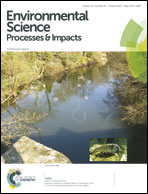Photosynthetic responses and accumulation of mesotrione in two freshwater algae
Abstract
Mesotrione is a herbicide used for killing annual grasses and broad-leaved weeds in maize. A recent investigation has shown that mesotrione has been detected as an organic contaminant in aquatic environments and may have a negative impact on aquatic organisms. To evaluate the eco-toxicity of mesotrione to algae, experiments focusing on photosynthetic responses and mesotrione accumulation in Microcystis sp. and Scenedesmus quadricauda were carried out. Both algae treated with mesotrione at 0.05–10 mg L−1 for 7 days reduced the photosynthetic capacity. The fluorescence of chlorophyll a, the maximal PSII activity (Fv/Fm), and the parameters (Ik, α and ETRmax) of rapid light curves (RLCs) in both algae were decreased under mesotrione exposure. The 96 h EC50 values for mesotrione on S. quadricauda and Microcystis sp. were 4.41 and 6.19 mg L−1, respectively. The latter shows more tolerance to mesotrione. Mesotrione was shown to be readily accumulated by both species. Such uptake of mesotrione led to the rapid removal of mesotrione from the medium. Overall, this study represents the initial comprehensive analyses of Microcystis sp. and S. quadricauda in adaptation to the mesotrione contaminated aquatic ecosystems.


 Please wait while we load your content...
Please wait while we load your content...